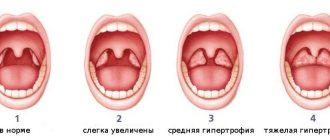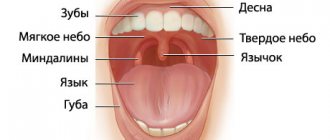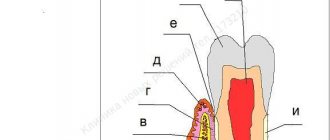Normal condition of tonsils
Tonsils are collections of lymphoid tissue located in the nasopharynx and oral cavity. Tonsils perform protective and hematopoietic functions, participate in the development of immunity - they are the first line defense mechanism against inhaled foreign pathogens. The full immunological role of the tonsils still remains unclear.
Together with other lymphoid formations of the nasopharynx, the tonsils form the pharyngeal lymphatic ring
The tonsils serve as a local immune organ, a kind of barrier against bacteria and viruses that enter the pharynx during the acts of breathing and swallowing.
Tonsils are divided into:
- paired: palatine - in the recess between the soft palate and the tongue (first and second tonsils).
- tubal - in the area of the pharyngeal opening of the auditory tube (fifth and sixth tonsils)
- pharyngeal (nasopharyngeal) - in the area of the fornix and the back of the pharyngeal wall (third tonsil, Luschka’s tonsil). Pathological enlargement of this particular tonsil is called adenoids
Localization and type of lingual tonsils
The lingual tonsil can be singular or paired
The lingual tonsil is located under the surface of the back of the tongue. It is a formation of lymphoid tissue in which the process of maturation of immune cells and the production of antibodies occurs.
Despite the fact that it is designated as an unpaired organ, most people have two such tonsils. This is explained by the symmetrical division of the organ’s lymphoid tissue into two parts.
The lingual tonsil in the photo is determined by an accumulation of lymphoid tissue consisting of follicles, so its structure appears heterogeneous. To determine how many lingual tonsils a person has, it is enough to carefully examine the groove at the base of the tongue. If it is very clear and noticeable, it means that the lymphoid tissue is divided into two organs and two tonsils. Interestingly, this division is not a pathology.
The anatomy of the lingual tonsil is simple. Having figured out where the lingual or uvular tonsil is located, you should understand the functions that this organ performs. Along with the palatine tonsils, the lingual tonsil is an organ of the immune system, acting as a barrier to germs and viruses that enter the body through the mouth. When there is a threat of penetration of pathogenic microorganisms, immune cells are formed and released in this tonsil, designed to protect against the disease.
Hypertrophy of the lingual tonsil
Under the influence of nicotine, the lingual tonsil becomes larger
Hypertrophy is the pathological growth of tissue, as a result of which the organ significantly increases in size. In fact, this is a type of tumor process that can be either benign or malignant. With hypertrophy of the lingual tonsil, an increase in neighboring organs of the lymphatic system is often observed, since they are all connected.
Hyperplasia is not always dangerous, but requires attention. Only a doctor after an examination can determine the degree of risk.
Reasons for the development of hypertrophy of the lingual tonsil:
- chronic inflammatory process in the palatine tonsils;
- inflammation of the lingual tonsil;
- previous tonsillectomy;
- smoking;
- exposure to chemical compounds and harmful fumes;
- genetic predisposition;
- human papilloma virus.
The most common cause of hypertrophy of the lingual tonsil is a chronic inflammatory process in the tonsils. The affected organ cannot cope with its functions, so other tonsils, in particular the lingual, enlarge to balance the work of the lymphatic system.
For the same reason, hyperplasia develops in people who have undergone radical tonsillectomy or surgery to remove the tonsils.
A factor contributing to hypertrophy of the lingual tonsil is smoking. Tissue proliferation in this case is explained by the constant harmful effects of chemical compounds in cigarette smoke. Due to constant intoxication, the tonsil cannot perform its functions and therefore increases in size.
Doctors consider genetic predisposition to be another reason for hypertrophy of the lingual tonsil. Statistics show that hyperplasia of lymphoid tissue occurs for no apparent reason in children whose parents have suffered severe diseases of the tonsils.
Manifestation of hypertrophy
The person begins to snore loudly and irritably
Knowing what the lingual tonsil looks like, you should pay attention to the symptoms of organ hypertrophy. The following symptoms are characteristic of hyperplasia of the lingual tonsil:
- difficulty swallowing;
- constant sensation of a foreign body in the throat;
- periodic bouts of unproductive cough;
- apnea and snoring;
- hoarseness and nasal voice;
- redness of the throat.
The danger is apnea - a sudden stop in breathing during sleep. This condition is very dangerous and requires timely treatment.
Note! Hyperplasia of the lingual tonsil cannot be detected independently in the mirror. Only a doctor can diagnose the disease after examination.
If the lingual tonsil is enlarged, a series of examinations are carried out, the purpose of which is to determine the type of tissue proliferation. There are benign and malignant hyperplasia of the lingual tonsil.
Benign hyperplasia
Benign tumors develop due to disruption of the natural process of cell division. They do not pose a threat to health, but require surgical intervention as they can interfere with normal breathing or cause any other discomfort, including snoring.
Benign hypertrophy is of two types - epithelial, consisting of epithelial cells, and non-epithelial, representing an accumulation of lymphoid tissue cells.
Epithelial growths are often associated with exposure to the human papillomavirus. Papilloma is a safe neoplasm, but requires removal as it can grow and increase in size.
Non-epithelial tumors of the tonsils - fibroma, angioma, lymphoma. Such tumors can manifest themselves as the proliferation of a network of capillaries in the lymphoid tissue.
Malignant tumors
Oncological diseases of the tonsils and tongue are quite rare, but therefore very dangerous. The problem with diseases of this group is difficult diagnosis. A malignant tumor of the lingual tonsil may not cause discomfort for a long time, remaining undiagnosed. When discomfort appears, surgical treatment in most cases is no longer possible.
Malignant growth of the lingual tonsil is a pathology with a high degree of mortality. It has no specific symptoms; you can suspect a problem when you feel a foreign object in your throat. Pathological enlargement of the lingual tonsil may be accompanied by changes in the palatine tonsils.
Tonsil hyperplasia in children
The child's body is often exposed to infections, such as whooping cough or scarlet fever. Hypertrophic processes are launched as compensatory ones. The diagnosis in question is made mainly to children under the age of ten years. Hyperplasia does not manifest itself as an inflammatory process. The tonsils are pale yellow in color, they are not red.
With the 1st degree of proliferation there are no symptoms. If growth is intense, then parents note a nasal voice of the child, breathing complications and other symptoms that were listed above. A large number of follicles, which are more fragile than normal, close the gaps without plugs.
Inflammation of the lingual tonsil
The disease can appear if you are very cold
The cause of inflammation of the lingual tonsil in the vast majority of cases are staphylococci and streptococci. As is known, these same pathogens provoke acute tonsillitis. In the vast majority of cases, the development of inflammation of the lingual tonsil is caused by a decrease in general and local immunity. The fact is that strong immune defense successfully copes with opportunistic bacteria, which are staphylococci.
The inflammatory process is indirectly related to chronic tonsillitis, since this disease provokes a decrease in local immunity, putting the remaining tonsils at risk.
Factors that provoke inflammation:
- decreased immunity;
- hypothermia;
- smoking;
- tonsil hypertrophy;
- glossitis;
- chronic source of infection.
Glossitis is an inflammation of the tongue. As with hypertrophy, the cause of inflammation of the lingual tonsil is often smoking, since nicotine and tobacco smoke reduce local immunity, increasing the risk of developing ENT diseases.
Interesting! Hypertrophy can be both the cause of inflammation of the lingual tonsil, and a consequence of this phenomenon, if the inflammatory process becomes chronic.
Contrary to popular belief, it is mainly adults who experience inflammation of the lingual tonsil; the disease is rarely diagnosed in children.
Symptoms of inflammation
Inflammation of the lingual tonsil is a disease that is difficult to distinguish from a photo, since it can inflame part of the tongue, the larynx and the palatine tonsils. The specific structure and anatomy of the lingual tonsil does not allow one to visually determine this disease independently. Everything is complicated by the symptoms of inflammation, which are characteristic of tonsillitis and pharyngitis. Signs of the disease:
- rawness and sore throat;
- redness of the throat and part of the tongue;
- swelling of the laryngeal tissues;
- pain when swallowing;
- foreign body sensation;
- white coating on the tongue and tonsils;
- enlarged lymph nodes under the jaw;
- increased body temperature;
- symptoms of intoxication.
In the absence of timely treatment, swelling of the epiglottis and swelling of the upper pole of the lingual tonsil appear. This is dangerous for breathing problems, even suffocation.
Quite often, when the lingual tonsil is inflamed, the palatine tonsils hurt, which is explained by the spread of infection throughout all vulnerable organs located in the affected area.
Causes of tonsil hyperplasia
For the occurrence of the disease, a damaging factor, for example, a burn, is important. In such situations, not only the tonsils are affected, but also the tissues adjacent to them. Not only too hot water, but also alkaline and acidic substances can damage the tonsils. For treatment of such patients, hospitalization is mandatory.
Among the reasons are the impact of a third-party object. Most likely these are small fish bones that violate the integrity of the lymphatic tissue. When swallowing, a person in such cases feels as if something is stabbing in his throat. The next reason is tumors and abnormal development of the tonsils. An organ can also be damaged if:
- contact with infected mucus (adenoiditis)
- mouth breathing, resulting in prolonged inhalation of cold air
- diseases to which the child was exposed at a young age
- relapses and frequent diseases of the ears, throat and/or nose.
The following children are at risk for tonsil hyperplasia:
- malnourished
- with poor living conditions, without proper care from parents or guardians
- imbalance of hormones in the body
- lymphatic-hypoplastic constitutional anomaly plays a role
- exposure to radiation for a long time
- lack of vitamins
Activation of the production of lymphoid cells plays a role in pathogenesis.
Treatment methods
If you feel discomfort in your throat and do not notice the symptoms of typical tonsillitis, you should consult a doctor as soon as possible. The doctor will be able to examine the patient’s throat in detail and make a diagnosis. Additionally, blood tests and a throat swab may be required.
Based on the examination results, the doctor selects a treatment regimen. For inflammation of the tonsil, conservative therapy is practiced; for hypertrophy, surgical therapy is used.
Drug treatment
The tablet is taken both before and after meals (it is recommended to take it with plenty of water)
Treatment begins with determining the cause of the disease. Both inflammation and hypertrophy are initially treated in the same way. Therapy consists of:
- antiseptic gargles;
- taking antipyretic and painkillers;
- antiviral, antifungal or antibacterial therapy.
A throat swab and blood test can determine the causative agent of the disease. For bacterial infections, broad-spectrum antibiotics are prescribed. They should be taken according to the doctor's recommendations; self-medication is unacceptable.
If the disease is viral in nature, for example, human papillomavirus or herpes, the drugs Acyclovir, Zovirax and their analogues are prescribed. These medications stop the activity of the virus and boost the immune system, helping it fight the disease.
Fungal infection of the lingual tonsil is quite rare, but such a disease can be completely excluded only after tests. If the cause is a fungal infection, the drugs Fluconazole, Itraconazole or Nystatin tablets are prescribed.
Additionally, it is necessary to provide antiseptic protection for the throat, otherwise the infection will quickly spread to neighboring organs. To do this, use rinses:
- Chlorhexidine;
- Miramistin;
- Chlorophylliptom;
- soda or salt;
- iodine solution;
- Lugol's solution;
- chamomile or calendula.
You can also treat the throat with an antiseptic spray; the medicine is also applied to the upper pole of the sublingual tonsil. This can cause a gag reflex, so treatment of the tonsils is carried out carefully.
Recommended sprays:
- Givalex;
- Inhalipt;
- Hexoral;
- Angilex.
Such drugs do not treat hypertrophy or inflammation, but prevent the development of complications and speed up recovery when taking antibiotics or other medications prescribed by a doctor.
To reduce tissue swelling, the doctor may recommend antihistamines, for example, Suprastin. Taking allergy pills will reduce swelling and make breathing easier.
During the inflammatory process, immunostimulants are additionally prescribed, for example, Lavomax or Arbidol.
For chronic inflammation, physical therapy techniques can be used to speed up tissue repair. As with tonsillitis, preference is given to UV irradiation (Solnyshko apparatus) or exposure to infrared rays.
Surgery
Enlargement of the lingual tonsil cannot be ignored
Removal of the lingual tonsil is indicated for severe tissue hypertrophy, suspected cancer, or chronic inflammatory process. Also, bacterial inflammation can develop into an abscess, which requires urgent surgical treatment.
Knowing where the lingual tonsil is located, it becomes clear that it is located in a place where a large number of blood vessels accumulate, so surgery is associated with the risk of bleeding.
The operation is performed under local or general anesthesia. The doctor excises the enlarged tonsil with a scalpel, then stops the bleeding and applies antiseptic and wound-healing agents to the area. Surgery to remove this tonsil carries a risk of wound infection, since the lingual tonsil is located in an area that is easily injured when eating, so antibiotics must be taken before and after the procedure.
After the operation, the patient experiences severe pain for several days, which gradually subsides. Rehabilitation takes an average of 2 weeks. In the first week after the operation, the diet changes radically; the patient will only eat pureed food at room temperature, so as not to injure the wound.
Diagnostics
An experienced doctor pays attention to the facial expression of a small patient. It is important to interview parents, and, if possible, the child himself, to identify the main complaints. The history may indicate such points as low immune defense of the body, respiratory diseases (several per year), and a stuffy nose for a long time. Laboratory tests are important to determine the diagnosis. It is necessary to identify the pathogen and check its response to commonly used medications. The patient is prescribed bacterial culture from the throat.
The patient's blood must be taken for analysis, including acid-base balance, and urine must be taken for analysis to detect inflammation. Instrumental diagnostic methods are also relevant when diagnosing tonsil hyperplasia. Ultrasound diagnostics of the pharynx, pharyngoscopy, fibroendoscopy and rigid endoscopy are performed.
Tonsil hyperplasia can be caused (must be taken into account when diagnosing):
- cancer in the tonsils
- tuberculosis
- granulomas of the pharynx of an infectious nature
- leukemia
- lymphogranulomatosis
Prevention
Leading a healthy lifestyle is one of the main rules
To avoid diseases of the lingual tonsil, it is necessary to strengthen the immune system. All methods are suitable for this - from hardening to taking vitamins. However, no preventive measures will work if there is a chronic source of infection in the body. First of all, you need to cure your teeth, chronic tonsillitis and other advanced diseases. Smokers should give up smoking, otherwise sooner or later chronic diseases of the tonsils will appear, including tissue hypertrophy.
If you suspect inflammation of the lingual tonsil, you should consult a doctor and not self-medicate. An advanced inflammatory process is dangerous due to an abscess of the lingual tonsil and inflammation of the lymph nodes.
Forecast
Doctors almost always give a favorable prognosis. Thanks to tonsillotomy, a person can breathe through his nose, and his immunity returns to normal. The brain functions without hypoxia, which normalizes the patient’s sleep and general well-being. Nasal voice also disappears after proper treatment. At an early age, moderate hyperplasia of the tonsils can be detected, but after the child reaches ten years of age, it goes away. If after 10 years hyperplasia still exists, you need to consult a doctor.
If symptoms appear, consult a doctor for early diagnosis and treatment.










